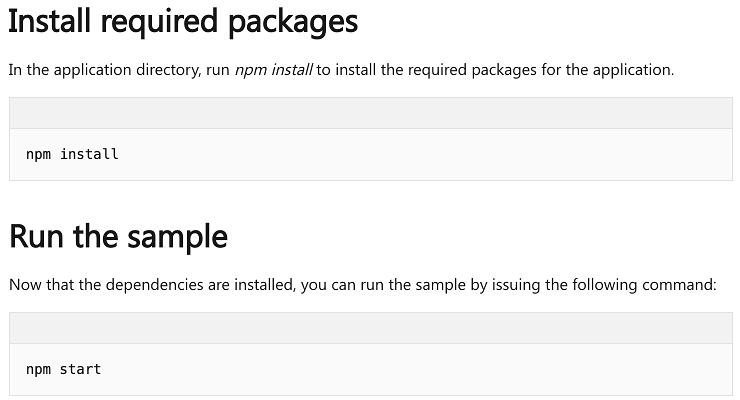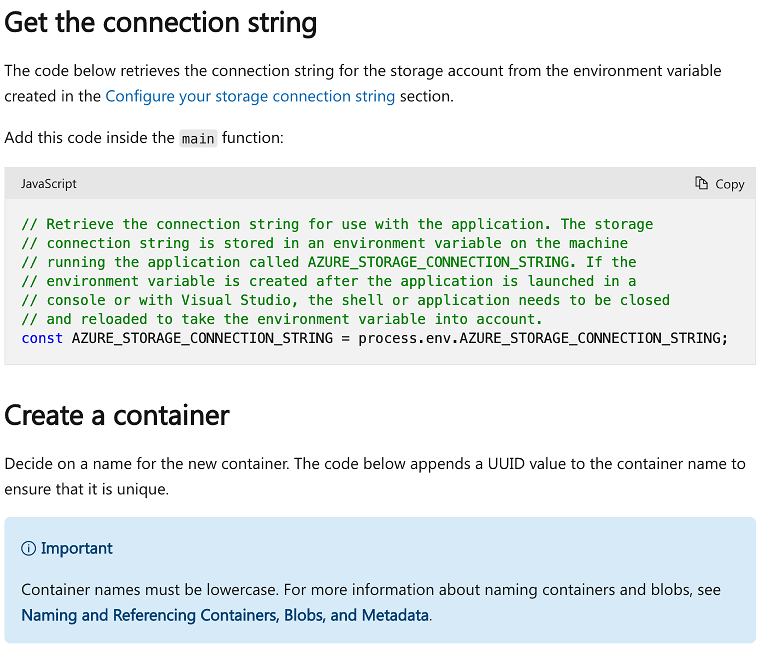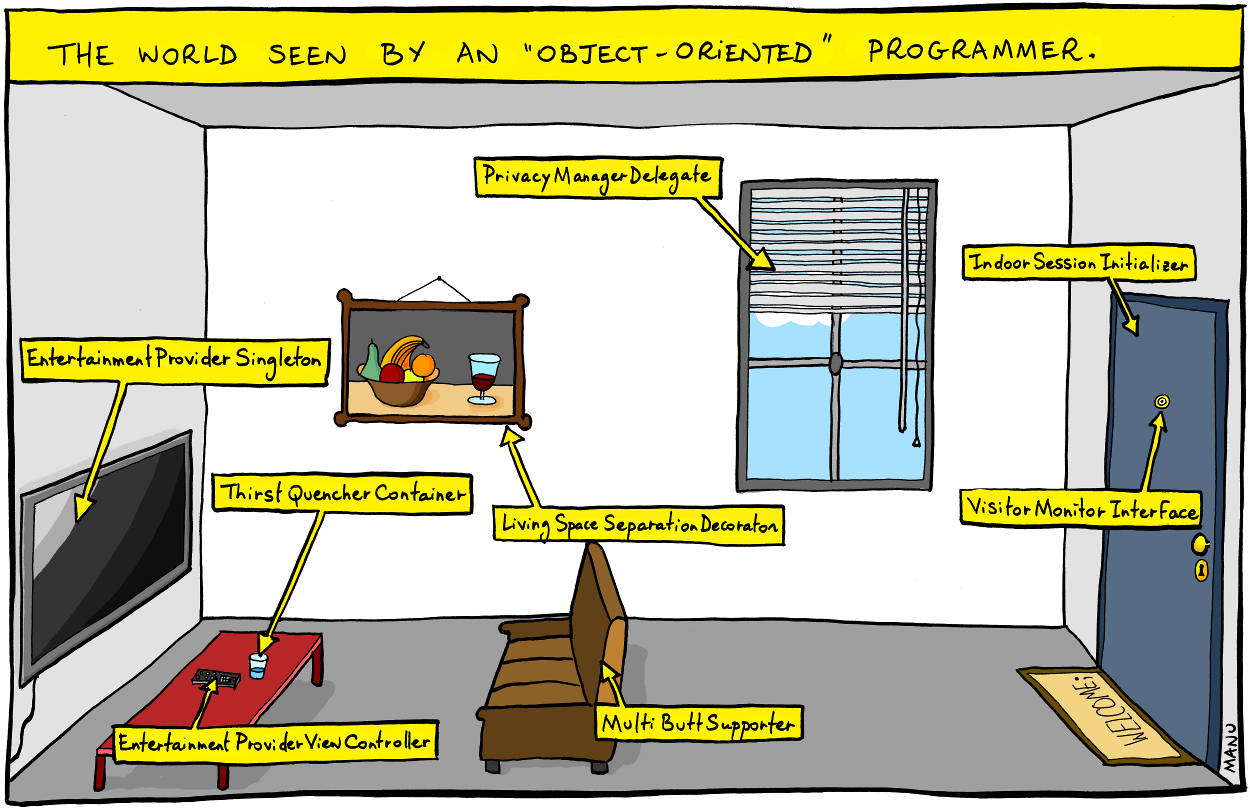How not to design an SDK
March, 2022 · 5 min read
There’s enthusiasm in the air as we start exploring a new library. It’s maintained and has a fair number of users. But frustration is about to set in.

The documentation takes forever to get to the relevant parts. The code examples? Talk about a worse signal-to-noise ratio. And once you scrutinize, things aren’t looking too great.
Enter the JavaScript SDK for Microsoft Azure’s Blob Storage. Particularly v10, which was the latest version until 2020. Its documentation doesn’t seem intended for developers, and its API is a textbook example of poor object-oriented programming.
Azure Blob Storage
Blob Storage, like Amazon S3, is a service used for serving static websites, storing media, and backups — data in general. Objects you upload are called Blobs, and a Blob belongs to a Container.
Microsoft provides SDKs in a handful of languages, wrapping the underlying REST API. Every SDK comes with a Quickstart, serving as documentation.
About JavaScript or the actual SDK?
Browsing the JavaScript SDK’s Quickstart, you need to scroll 50% through it before any real action happens.

It starts by explaining how you clone repos and manage environment variables. Then, the advanced concepts of npm install and npm start each have their own Heading 2. Further down are explanations of fs and path, how variable assignment works, and why a top-level async function is needed. An additional page or two later, we finally see snippets demonstrating how to create a Container and upload a Blob.
It’s better than nothing. But it wouldn’t be outlandish to assume that people seeking an SDK for a specific language understands its basics. It also feels excessive to provide a line-by-line commentary of example code, which should be simplistic in the first place.

"Object-oriented" programming
Imagine you’re designing an SDK for Blob Storage: users want to be able to create Containers and upload Blobs to them. What’s your ideal experience for this?
Here’s the minimal code for uploading a Blob to a Container using v10 of the JavaScript SDK.
const {
SharedKeyCredential,
StorageURL,
ServiceURL,
ContainerURL,
BlockBlobURL,
Aborter,
} = require('@azure/storage-blob');
const STORAGE_ACCOUNT_NAME = 'johanli';
const ACCOUNT_ACCESS_KEY = 'something';
const container = 'myWebsite';
const blobName = 'index.html';
const body = 'Hello, World!';
const credentials = new SharedKeyCredential(
STORAGE_ACCOUNT_NAME,
ACCOUNT_ACCESS_KEY,
);
const pipeline = StorageURL.newPipeline(credentials);
// either
const serviceURL = new ServiceURL(
`https://${STORAGE_ACCOUNT_NAME}.blob.core.windows.net`,
pipeline,
);
const containerURL = ContainerURL.fromServiceURL(serviceURL, container);
const blockBlobURL = BlockBlobURL.fromContainerURL(containerURL, blobName);
// or
const blockBlobURL = new BlockBlobURL(
`https://${STORAGE_ACCOUNT_NAME}.blob.core.windows.net/${container}`,
pipeline,
);
const aborter = Aborter.timeout(300000);
blockBlobURL.upload(aborter, body, body.length).then((response) => {
console.log(response);
});Where do we even begin?
The SDK’s underlying code is all-out object-oriented. There’s nothing inherently wrong with that. But read out loud the classes it provides us: SharedKeyCredential, StorageURL, ServiceURL, ContainerURL, and BlockBlobURL. A famous comic springs to mind:

The numerous URL classes also give you the impression of forming URLs for you. But no — their constructors expect you to provide the entire URLs (see .blob.core.windows.net). Additionally, STORAGE_ACCOUNT_NAME has to be passed both to SharedKeyCredential and ServiceURL.
Next in line, we’ve got pipeline, obtained from StorageURL. It’s an implementation detail. There’s no reason an SDK user should care about it unless it needs manual unclogging.
Finally, look at the upload method. Of all things, an Aborter object is the first argument. Why’s it so important? Preferably, I’d want a default that I can override if necessary. And content length being a required argument feels inconvenient when it’s something the SDK can figure out.
I’m being harsh. For all I know, the SDK might’ve been thrown together by people new to software development with no one to guide them. But keep in mind: this is the official JavaScript SDK of Blob Storage. It’s on its tenth major version, and all for the sake of wrapping a REST API.
A good SDK
How does a good experience look like? Here’s the minimal code to upload something to S3 using AWS’s SDK:
const AWS = require('aws-sdk');
const container = 'myWebsite';
const blobName = 'index.html';
const body = 'Hello, World!';
const s3 = new AWS.S3({
credentials: {
accessKeyId: 'johanli',
secretAccessKey: 'something',
},
});
s3.upload({
Bucket: container,
Key: blobName,
Body: body,
})
.promise()
.then((response) => {
console.log(response);
});Beautiful. There’s no pipeline, pigeonPost, or smokeSignal going on here. You don’t form URLs. Everything looks sensible.
Opinions about the Java SDK
Is the JavaScript SDK just an aberration? Out of curiosity, I checked out the other SDKs. This API is useless (v10), lo and behold, is the top-upvoted GitHub issue in the Java SDK. It starts off with a bang, with spicy statements:
The API is an unintuitive mess. Documentation is rubbish and out of sync with code, and the example is useless.
I’ve been doing Java professional, every day, for 18 years, but never seen such a poor API.
stop developing on the version 10 API and Kill it. KILL IT WITH FIRE!
Based! The original poster is particularly riled up because v10 feels like a leap backwards compared to the now deprecated v8. Further, he elaborates:
The naming of BlobSASSignatureValues is really bad. It tells me absolutely nothing about what its purpose is. I would think it is simply a POJO class for holding some values. The name indicate it is a class of values, not a class of functionality.
This is reminiscent of the classes from the JavaScript SDK ending in URLs. Later in the conversation, two other developers chime in:
We’ve also been using this (a team of advanced java developers) and have been struggling with getting it to work correctly.
I am giving serious consideration to just calling the REST endpoints directly instead of using the SDK
Folks, we’ve found two litmus tests of whether an SDK is useless. What follows is the original poster explaining what they expect from an SDK, dropping the mic:
First of all it should help me save time getting my job done. If using the SDK will cost me more time that going low level and e.g. call a rest interface myself, the SDK has failed.
The SDK should hide the complexity about the service I’m using. I don’t care on bit if this SDK is communicating with the Azure service using REST, gRPC or rfc1149 as long as it is efficient. Using the SDK should make my codebase simpler than if I have not used it and it should improve maintainability.
The SDK should be self explanatory and intuitive. If I need to read more than a few lines getting started, performing simple tasks, it has failed.
It need to be stable and predictable so my time invested using the SDK is not wasted. Throwing an existing solution away to start from scratch should be avoided if possible. It need to evolve in a way so not to many breaking changes are introduced, preferable using semantic versioning.
Preach brother, preach! Give this man a gold star! And he’s even thrown in a subtle pigeon reference as well.
Takeaways
An SDK is a product. As with any product, what’s the value-add? Why would people use it, and who are they? Steve Jobs once said, “you’ve got to start with the customer experience and work backward for the technology.” Otherwise, you’re giving the impression that the sole purpose of your SDK is so you can add a check to your sales deck.
Also, we sometimes miss the forest for the trees. If you look into the source code of the JavaScript SDK v10, it’s obvious there’s a lot of object-oriented programming going on. Yet, it failed with one of the core concepts of OOP — that of providing actual abstractions.
References
Git repository (v10) and links to the Quickstart (v10 and v12):